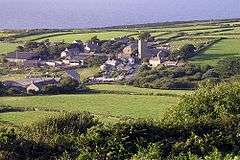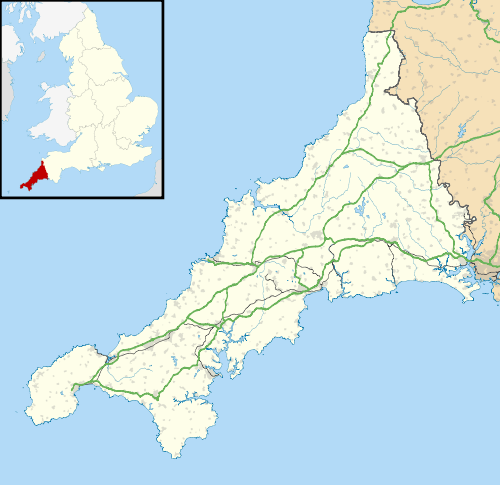Zennor
| Zennor | |
| Cornish: Sen Senar | |
 Zennor from Trewey Hill |
|
 Zennor |
|
| Population | 196 (civil parish, 2011 Census) |
|---|---|
| OS grid reference | SW458384 |
| Civil parish | Zennor |
| Unitary authority | Cornwall |
| Ceremonial county | Cornwall |
| Region | South West |
| Country | England |
| Sovereign state | United Kingdom |
| Post town | ST IVES |
| Postcode district | TR26 |
| Dialling code | 01736 |
| Police | Devon and Cornwall |
| Fire | Cornwall |
| Ambulance | South Western |
| EU Parliament | South West England |
| UK Parliament | St Ives |
Coordinates: 50°11′31″N 5°34′05″W / 50.192°N 5.568°W
Zennor /ˈzɛnər/ is a village and civil parish in Cornwall, England, United Kingdom. The parish includes the villages of Zennor, Boswednack and Porthmeor and the hamlet of Treen. Zennor lies on the north coast, about 6 miles (10 km) north of Penzance,[1] along the B3306 road which connects St Ives to the A30 road. Alphabetically, the parish is the last in Britain. Its name comes from the Cornish name for the local saint, Saint Senara.[2]
Zennor Head is a coastal promontory north of the village. The cliffs rise over 200 feet (60 m) from the sea and the highest point of the headland is 314 feet (96 m) above sea level.[1] The village itself is at a height of around 360 feet (110 m).
Zennor lies within the Cornwall Area of Outstanding Natural Beauty (AONB). Almost a third of Cornwall has AONB designation, with similar status and protection as a National Park.
About a mile east of the village is the Zennor Quoit megalithic site.[3]
Helen Dunmore's 1993 novel Zennor in Darkness is set in and around the village in 1917 when D. H. Lawrence lived nearby. Zennor is also mentioned in the Ulysses Moore series of books, written by Pierdomenico Baccalario; in fact near Zennor and Saint Ives there would be the mysterious hamlet of Kilmore Cove, the place where the series is mainly set.
Local government
For the purposes of local government Zennor elects a parish council of seven members every three years.[4] Higher functions are exercised by Cornwall Council. Until March 2009 the parish was included in the former Penwith Council District.
Facilities
As well as a public house, the Tinner's Arms, next to it is a guesthouse[5][6]
History and antiquities
Antiquities include the megalithic burial chambers Zennor Quoit and Sperris Quoit (only 400 yards apart). There is a prehistoric entrance grave at Pennance known as the Giant's House and not far away are four round barrows. Gurnard's Head, or Trereen Dinas, is an Iron age promontory fort (or cliff castle) with five lines of fortification, and a mile to the west is Bosigran, close to Treen (Cornish: Tredhin), a second promontory fort along with a surviving field system.[7]
According to local knowledge, the historical and locally populous and influential Stephens family originated here, arriving in a shipwrecked cattle boat in 1470, two other men were reputably aboard (one of whom started the Quicks of St Ives) the shipwreck occurred at Wicca pool, the boat having been traveling from Ireland.[8][9][10]
Between 1915 and 1917 writer D. H. Lawrence lived near the village with his new wife Frieda. It was during this time that he finished Women in Love. The couple were later accused of spying and signalling to German submarines off the Cornish coast and in late 1917, after constant harassment by the armed forces authorities, Lawrence was forced to leave Cornwall at three days' notice under the terms of the Defence of the Realm Act (DORA). This persecution was later described in an autobiographical chapter of his Australian novel Kangaroo, published in 1923. In September 2016 events were held to celebrate the centenary of Lawrence's connection with Zennor.[11]
In 1943, the middle of World War II, No. 4 British Commando were involved in a mock seaborne raid codenamed "Exercise Brandyball", which took place on the 300-foot (90 m) cliffs, near Bosigran, known as the 'Brandys'.[12] The training exercise was deemed one of the most hazardous and challenging of the war,[13] beginning with a seaborne landing,[12] followed by a climb up the vertical cliffs with full kit to destroy the target, an old disused tin mine. On the rehearsal day of 6 June, the weather was not good and one of the boats sank with the loss of two commandos. These events were filmed by Allied officers,[12] as observers from all the services were present, including General Bernard Montgomery. The archives are now held in the Imperial War Museum.[12] The following day the men decided the operation should continue, and it was successfully completed on 7 June.[12][14]
Parish Church of St Senara
The Church of Saint Senara is partly Norman and partly of the 13th and 15th centuries (the north aisle 15th century). There is a west tower and the octagonal font may be from the 13th century. One of only two remaining bench ends portrays the Mermaid of Zennor.
Little is known of St Senara, although legend connects her to Princess Asenora of Brittany.[15][16]
Late Cornish language use
The village of Boswednack was home to a small community of Cornish speakers during the 19th century. These included John Davey Jnr., 1812-1891 and his father, as well as Anne Berryman (1766-1854), and John Mann (1834-1914). John Mann recalled in an interview that, when a child, he and several other children always conversed in Cornish while at play together.[17][18] It is from John Davey that we know the Cranken Rhyme, probably the last recorded piece of traditional late Cornish verse.
The mermaid of Zennor
The legend of the mermaid of Zennor concerns a mermaid that visits St Senara's Church and entices local parish singer Mathey Trewella away. The legend was probably inspired by a 15th-century carved bench-end in the church that shows a mermaid.[19]
In its turn, the legend has inspired Vernon Watkins' poem "The Ballad of the Mermaid of Zennor",[20] Sue Monk Kidd's novel The Mermaid Chair, Cornish poet Charles Causley's book The Merrymaid of Zennor, the song "Mermaid" by Cornish folk singer Brenda Wootton,[21] and Helen Dunmore's Ingo Chronicles.
Patrick Heron
Artist Patrick Heron lived in Cornwall until the age of nine and he returned in 1956 to live at "Eagle's Nest", overlooking the cliffs near Zennor. Many of the sharp-edged shapes in his works are reminiscent of the aged Cornish coastline, while the rounded shapes recall the granite boulders in his own garden. He died peacefully at his home in Zennor in March 1999, at the age of 79, and many of his works are displayed at the Tate St Ives.[22]
Gallery
- Zennor Church
- Zennor Church from the northeast
 Zennor Church (interior, with Mermaid Chair)
Zennor Church (interior, with Mermaid Chair)_(9612120).jpg) Zennor Quoit, about a mile southeast of Zennor village
Zennor Quoit, about a mile southeast of Zennor village- View to the east from Zennor Head
- View to the west from Zennor Head
- Zennor Head in the evening
 The pine, the pub sign and the church
The pine, the pub sign and the church
References
- 1 2 Ordnance Survey: Landranger map sheet 203 Land's End ISBN 978-0-319-23148-7
- ↑ Warlinnen - The Cornish Language Online Archived 18 October 2006 at the Wayback Machine.
- ↑ "Local information guide" (PDF). Retrieved 6 September 2015.
- ↑ "Zennor Parish Council". www.cornwall.gov.uk. cornwall council. Retrieved 6 September 2015.
- ↑ "Zennor Chapel Cafe Guesthouse". zennorchapelguesthouse.com. Retrieved 1 May 2016.
- ↑ "Tinners Arms website". tinnersarms.com. tinners arms. Retrieved 1 May 2016.
- ↑ Nicholas Johnson and Peter Rose (1990). Cornwall's Archaeological Heritage. Truro: Cornwall Archaeological Unit. ISBN 0-906294-21-5.
- ↑ "Wicca Pool Shipwreck". proboards. Retrieved 6 September 2015.
- ↑ "Shipwreck off Zennor". ancestry. Retrieved 6 September 2015.
- ↑ Matthews, John. A History of the parishes of St. Ives, Lelant, Towednack and Zennor: in the county of Cornwall. Cornwall.
- ↑ "Centenary events will celebrate DH Lawrence's time in Zennor". westbriton.co.uk. 5 September 2016. Retrieved 11 September 2016.
- 1 2 3 4 5 Johnston, John Norman (7 June 1943). "Exercise Brandyball (film)". Imperial War Museum. Retrieved 27 October 2012. retrieved 27 October 2012
- ↑ Will Fowler (18 June 2012). Allies at Dieppe: 4 Commando and the US Rangers: Operation Cauldron. Osprey Publishing. pp. Appendix 2. ISBN 978-1-78096-596-3. Retrieved 21 October 2012.
- ↑ Dunning, James (2003). The Fighting Fourth : No. 4 Commando at war 1940–45 (First ed.). Stroud, [England] : Sutton, 2003. p. 109. ISBN 978-0-7509-3095-6. OCLC 630147678.
- ↑ St. Senara's Church at zennor.org Archived 23 March 2012 at the Wayback Machine.
- ↑ Bede, Eccl. Hist. Book 3, chapter 23.
- ↑ Rod Lyon, Cornish – the Struggle for Survival, 2001
- ↑ Legend Dolly Pentreath outlived native tongue; Thisiscornwall
- ↑ Pritchard, George. "The Mermaid of Zennor". Cornish Legends Saints, Mermaids & Phoenicians. Retrieved 14 June 2012.
- ↑ Watkins, Vernon (1962). Affinities (PDF). London: Faber and Faber.
- ↑ Boy Jan ... Cornishman, (1980), Burlington Records, BURL 005, sleeve notes
- ↑ Patrick Heron, St Ives painter Archived 16 April 2009 at the Wayback Machine.
- The Mermaid of Zennor; Cornishculture
External links
| Wikimedia Commons has media related to Zennor. |